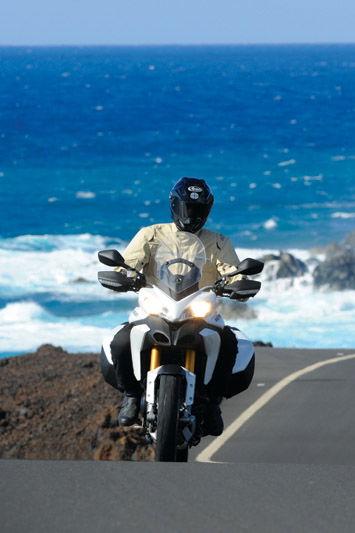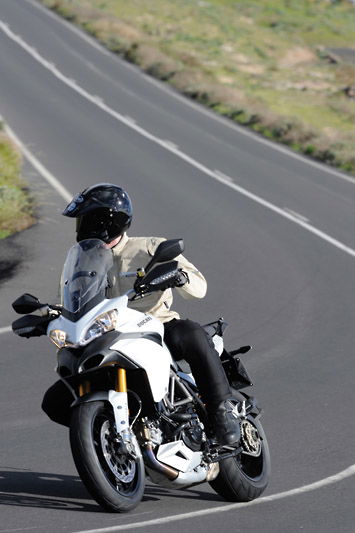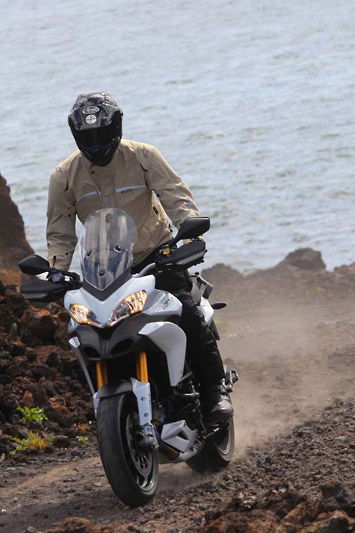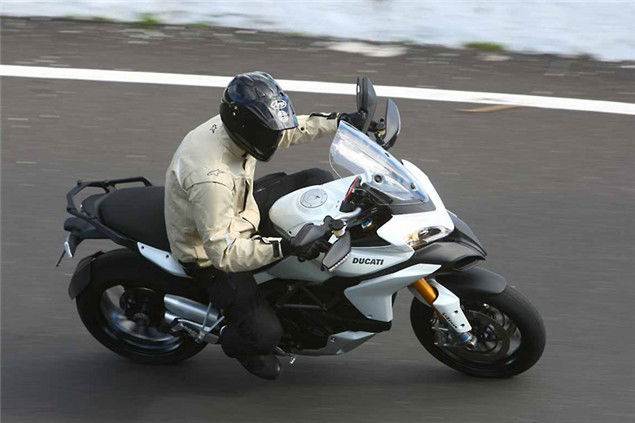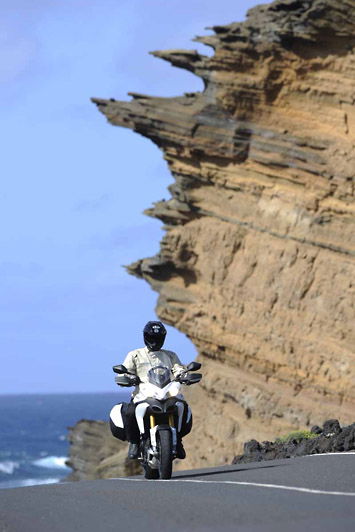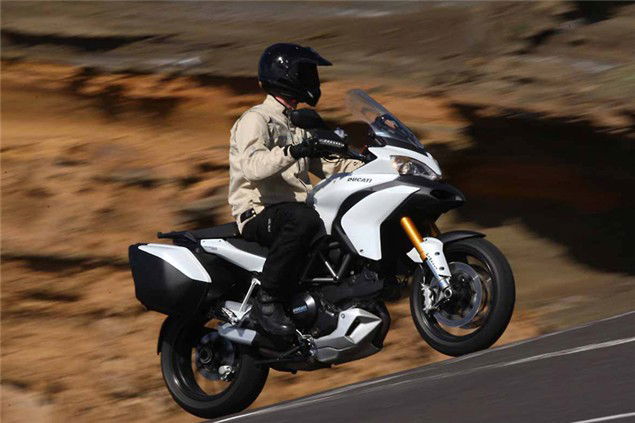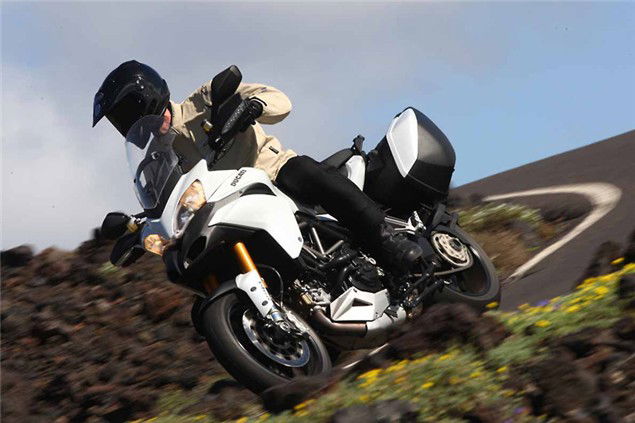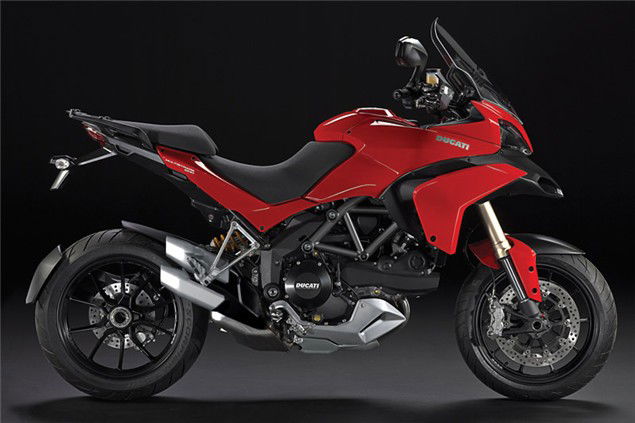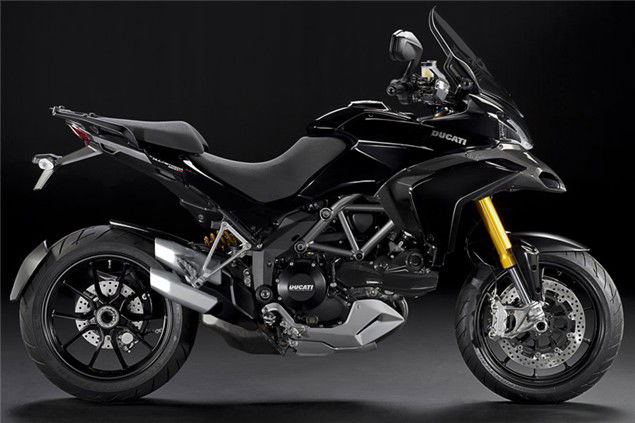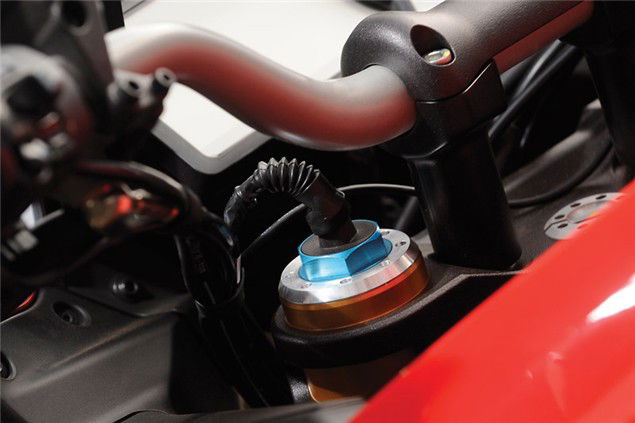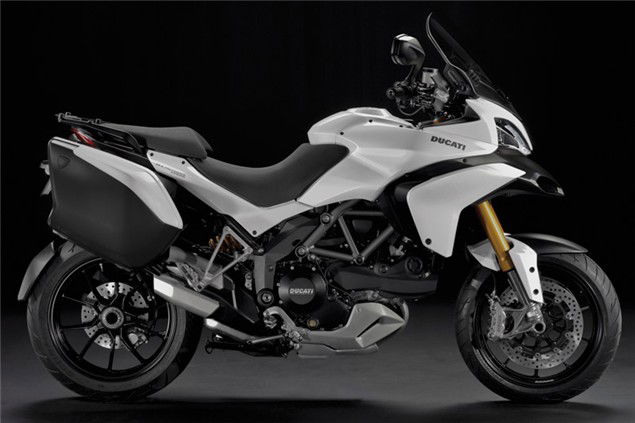2010 Ducati Multistrada 1200 launch test review
One of the most eagerly awaited motorcycles of 2010 broke cover in the volcanic heat of Lanzarote. Ducati’s complete revision of the Multistrada could be enough to steal top all-rounder tag from the BMW R1200 GS. Here’s how the first ride went down

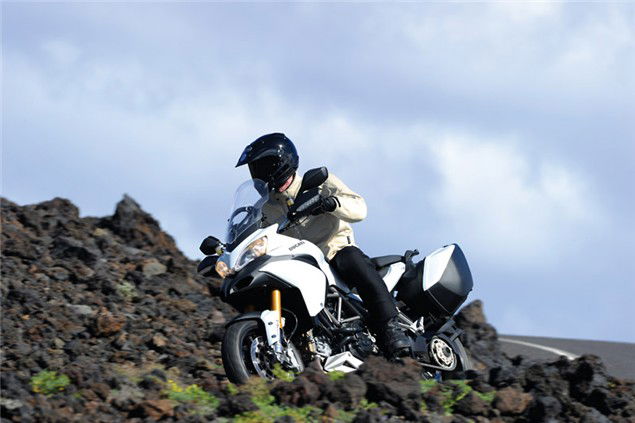
Click here to read: Ducati Multistrada 1200 owners reviews, Ducati Multistrada 1200 specs and see the Ducati Multistrada 1200 photo gallery.
First impressions are positive. The bulbous frog-like expression of the Multi’s front fairing now looks razor sharp and bang up-to-date, with a hawk-like appearance thanks to the aggressively styled twin air ducts and purposeful looking twin headlights.
The Multistrada was previously ensconced in the love it or hate it ‘Marmite’ category. If you could see past the controversial exterior, the view from the cockpit and the overall riding experience rewarded the less shallow rider with a bike that was capable of two-up touring, city commuting or a good blast through your favourite back roads on a Sunday morning. The new model is almost sylph-like by comparison, sharp styling, a low GP-style twin exhaust, and trademark single-sided swingarm say this bike wants – no, demands – to go and play.
To appeal to a wider audience, Ducati has made the brave claim that the new 1200 is a four-in-one motorcycle; sports, tourer, urban commuter and enduro machine. Lanzarote, in the Canary Islands proves a good testing ground for these bold claims. Perfectly asphalted roads snake their way around 807 square kilometers of biking nirvana.
The brief Ducati presented to the development team was originally viewed as nothing short of a pipe dream. “To produce the greatest Ducati of all-time, an urban bike but with no limiting barriers. It would be a dream, an impossible one to make a bike like this. We had to change the way we thought, the way we designed our products at Ducati,” said product manager, Mario Alvisi.
By taking features from other models, including the signature trellis frame, Ducati Traction Control, L-twin engine, and then incorporating them into one streamlined package, Ducati appears to have risen to this challenge, turned the dream into reality, etc, etc. And maybe unleashed a motorcycle that ticks all the right boxes for all but the most diehard sportsbike fanatics.
Ducati Traction Control (DTC)
Derived from race technology, DTC controls rear wheel spin. The Multi offers eight levels of control from zero (no traction control) to 7 (high interference). Each riding mode is default set to an optimum level of traction control – 4 for sport, 5 for touring, 6 for urban and 2 for enduro. Software analyses data from front and rear wheel sensors to determine the level of DTC required at any point to ensure smooth and safe riding. The amount of ‘interference’ will differ depending upon the dynamic situation, for example slow mid-corner acceleration to prevent high-sides. Although default set, DTC can be adjusted in each rider mode.

But don’t be misled, the Multistrada is no re-hash. It’s been carefully thought out and engineered to include a number of firsts on a road bike for the Bologna factory including; ride-by-wire throttle, Ducati Electronic Suspension (DES) and bespoke Pirelli Scorpion Trail rubber - all powered by a refined Testastretta engine.
Aside from the Multistrada moniker, and the Ducati logo on the tank, the new 1200 shares nothing with the outgoing model. Ducati has spent over two years, built 110 pre-production bikes and ploughed through 210,000 test miles to bring the Multistrada up to scratch and release what it should have been in 2003.
Heaving a leg high enough to avoid kicking the panniers, I sit in the spacious cockpit. This is a vast improvement over the 1100 model. Rider ergonomics and comfort were paramount to Ducati’s design brief. The two-part stepped seat offers both rider and pillion sumptuous comfort and it’s only after a good three hours in the saddle I get a numb bum. At six foot six I tend to dwarf most motorcycles on the market. Perhaps it’s no exception with the 1200 but despite the wheelbase being shorter than that of the GS, the cockpit feels comfortable and roomy.
The screen’s taller than the previous model and with 60mm of height adjustment this means a lot less wind blast onto my chest. The wide tapered bars offer plenty of feel and feedback, even off-road, and with a steering lock angle of 76-degrees (38-degrees on each side), slow-speed manoeuverability is a doddle. Couple this with it being mounted on anti-vibration isolators and the whole riding experience becomes less painful due to the decrease in vibration. The mirrors, though bigger, still vibrate and distort rear images over 80mph. Well it’s a Ducati...
For the first time, Ducati has used a hands-free ignition system. Keep the key in your pocket and it will activate the ignition when you get within about six foot of the bike. A dedicated key code is recognised and all systems are go. Simply click your way through the simple start procedure on the right hand controls and off you go. There’s also an electronic steering lock that activates when the bike is put on full lock with the ignition off. For me, the safest place to leave the key was in the cubby-hole in the fairing. But I’m eternally worried I’ll lose the key.
Once fired up, the electronic two-part dash is simple, clear and well-stocked with important features. The main large LCD display contains all the usual main riding data needed as well as a gear indicator – a feature that with my goldfish brain capacity I tend to find invaluable on a motorcycle and don’t understand why they don’t all come like this. To the right is a dot-matrix circular LCD screen that displays the riding modes, additional data and set-up menus that are available depending on whether the bike is stationary or moving.
Ducati Electronic Suspension (DES)
The S model is equipped with 48mm Öhlins forks featuring DES suspension. Rebound and compression damping are adjusted electronically via the control panel. The new Öhlins TTX race-bred rear shock is also electronically adjusted for spring pre-load, rebound and compression damping. The suspension varies in the four modes of sport, touring, urban and enduro, with further options available at the touch of a button to suit rider only, rider with luggage, rider with pillion and rider with luggage and pillion. This equates to 16 different basic suspension settings that can then be further personalised by riders in independent mode to their own settings. You can’t retro-fit DES to the base model Multistrada making the S the machine of choice.
Perhaps the most important aspect of the display is the Mode selection function. By using the indicator cancel button the rider can switch between four different modes; sport, touring, urban and enduro. In itself this may not be a ground-breaking development.
However, within these four modes it is then possible for the rider to select a host of other settings to control power (150bhp or 100bhp), seven levels of traction control, and for S model owners, the capability to electronically adjust the Öhlins suspension.
For each riding mode, Ducati has installed default settings determined as the mean optimum for riding. However it’s a simple task to personalise the settings and Ducati dealers may also have the facility to further enhance these modes with precision fine-tuning through exact owner settings. As standard, there are no fewer than 16 different suspension settings – four for each mode.
Making our way round a 250km circuit from Playa Blanca at the southern end of Lanzarote though the volcanic core of the island up to Orzola Punta Norte at the northern tip, I have the opportunity to experiment fully with the riding modes, selecting different rider preferences to see just how the suspension is affected and to try to find my optimum setting from the basic default settings.
In Touring mode the suspension is perhaps a little too soft to make the most of the very neutral and stable front end, but this could easily be stiffened by telling the Strada that I have a pillion on the rear. In enduro mode, the DTC kicks in way too early almost spoiling any rear wheel sliding fun you might be thinking of having. Of course, this can all be adjusted, given time, to suit your route ahead by scrolling through the options.
For wide, open sweeping roads the lower power delivery of the touring mode is the best option. The engine pulls strongly from low revs and cruises comfortably in sixth at 80-90mph, the revs brushing 6,000rpm. A quick flick through the mode selector to sport for the twisty tarmac sections allows a more aggressive riding programme, the power coming in sooner mid-corner to increase exit speed, propelling you forward with a healthy surge and great confidence.
There are a few times I begin to get sucked in by the sweet Lanzarote tarmac, my mind not quite as sharp as it should be. But without panic, a firm tug on the brakes rights any wrongs, even deep into a corner, without unsettling the bike too much.
Testastretta 11° Engine
The 1198cc, water-cooled engine is borrowed from the 1198 superbike, but with refined internals to produce smoother power delivery. The lower valve overlap angle of just 11° (reduced from 41°) is essential to the success of a more user-friendly, situation adaptable, smooth operation. Sportsbikes have a high angle to maximise raw power, but for all-round use Ducati has reduced the overlap of intake and exhaust valves to soften the power delivery. The effect is more useable torque is produced at low revs, with a smooth power delivery throughout the range up to a maximum of 150bhp at 9,250rpm, compared with 170bhp at 9,750rpm on the superbike. Although bore and stroke remain the same, compression ratio is reduced to 11.5:1 from 12.7:1. The Multistrada also boasts a wet clutch to boost longevity, fitted with a self-servo mechanism that pushes the clutch plates together when the engine is driving then reduces pressure on the over-run to act as a slipper clutch for smoother braking. The upshot is that Ducati has finally made a clutch with a light action. Improved reliability and lower maintenance/servicing costs should also be also part of the deal.
Dropping down into the busy market town of Yaiza I hit urban mode. You can instantly feel the power decrease to just 100bhp and the whole flavour of the bike takes a much more laid back approach, nimbly navigating through the waves of traffic. Once outside the urban scenario, it’s back to play with the sports and touring modes.
At the heart of the Multistrada is the Testastretta L-twin motor as used in the 1198, but radically refined to adapt to each riding mode. Power delivery is smooth, right from 1,250rpm at idle through to the full 150bhp at 9,250rpm. Compared with the superbike engine, there’s more power below 4,000rpm. And with gear ratios altered to make sixth effectively an overdrive, cruising speeds of 80mph are reached with minimum strain on the motor and maintained with much less engine noise.
With 80% of potential customers said to be opting for the more highly spec’d S model, we split our time between the S Sport and the fully-fledged S Touring. While both share the DES, DTC, ABS, the Sport receives a smattering of carbon clothes while the Touring comes laden with panniers, heated grips and a centrestand. Potentially, the centrestand is a negative. Anything over a size six boot (mine are a 13) and your heel continuously rests on the stand sending vibration through your left leg. The only real remedy is to keep altering your foot position.
The panniers are fairly spacious, with a combined capacity of 57-litres and an optional 78-litre (two full-face helmets) topbox available. Briefly testing two-up capabilities, the pillion footpegs are not hampered by the panniers which act as a nice leg rest. The substantial pillion grab rail is more than ample.
Extras on the Multistrada may seem small but can be quite significant depending upon the situation. Two 12V power outlets are hidden under the rider’s seat, one each side, for an intercom, mobile phone or heated clothing. There’s a separate connection point for a Garmin GPS hidden in front of the bars. Ducati has finally added some onboard carrying space with a 3-litre underseat area and a smaller storage box in the front right fairing. This is billed as a mobile phone holder yet clearly didn’t take into account the popularity of iPhones or others of a similar size. To help with raising the bike up onto its centrestand, a neat little foldaway lever sits by the right pillion footrest point.
Ride-by-Wire
This is a first for Ducati although not new in the two-wheeled world. Yamaha, BMW and Aprilia, to name a few, already use a very similar system. While the throttle twistgrip still has a cable it isn’t directly connected to the throttle butterflies but instead runs to a sensor which then electronically operates the butterflies. In other words your right hand isn’t directly connected to the power, a computer interprets your movements. The Multistrada comes with three different maps that regulate the power delivery – 150bhp with a more instant high-level sports type delivery, 150bhp with a progressive response designed for touring and a limited 100bhp for urban or off-road use.

Many motorcycles, especially touring models, are released with a limiting fuel capacity, but the Multistrada’s 20-litres is good for an average of around 250 miles, bringing in a healthy fuel consumption return of 56 mpg on a conservative ride.
The new chassis has been developed to compete in terms of balance of stability, strength and dynamic agility. Lean angles of up to 45-degrees mean this bike could cut it admirably on track, while the four-part frame comprising of tubular steel Trellis at the front, central cast aluminium sections and a rear Techno-polymer sub-frame increase overall stiffness by almost 20% over the old 1100 model. The whole chassis geometry, including wheelbase ensures that any added weight to the motorcycle is kept within bounds so as to add to rather than decrease overall performance.
So, what about the tyres? It seems odd Ducati would produce a bike with alleged off-road capabilities running on a sports 17-inch front rim. Yet when you consider Ducati also wanted the Strada to clock fast track times, cope with B-road hacking, touring and urban commuting, there wasn’t really any choice. Pirelli rose to the challenge and the bespoke Scorpion Trail tyres worked well. Gaining heat at a rate of knots, you can soon flick the MST through the corners and hold a planted line, the beefy 48mm Öhlins forks retain neutral poise. Braking is a revelation too. After an initial lull the ABS kicks in and the bike is firm, tyres gripping tarmac with confidence. Even braking late into a corner doesn’t unsettle things and at no point do you get the impression the ‘slick’ edges will let go.
I don’t think many prospective owners would be looking to take the MST off-road. The front wheel is too small and unless you pre-select zero traction control you’ll never get the full off-road experience and enjoyment that the KTM Adventure offers. Our short 5km test on a rippled, pot-holed dust track gives a basic glimpse of what this bike may be capable of attacking, but a few fire roads is really the limit of its off-road sorties. All said and done, would you really want to risk 14 grand’s worth of Ducati on a precariously muddy dirt track?
In the presence of its peers, the Multistrada is yet to showcase its obvious talents. The BMW GS may still be the consummate tarmac tool for many and the KTM more geared-up for off-road exploration, but the Ducati can compete. Finally living up to the ‘many roads’ moniker.
If recession-hit potential customers’ wallets can stretch to the £14k asking price of the S-model, and judging from pre-orders they can, the Multistrada 1200 just might spawn a new breed of Ducatisti.
Ducati Multistrada Specifications
Ducati Multistrada 1200
Price £10,995 (non-ABS) Top speed 150mph (est)
Engine Liquid cooled, 4-valve per cylinder, L-twin, Desmodromic, 1198cc
Power 150bhp @ 9,250rpm Torque 87.5ft.lb @ 7,500rpm
Front suspension Marzocchi 50mm USD forks, fully adjustable
Rear suspension Sachs Monoshock, fully adjustable
Front brakes 320mm discs, four piston Brembo calipers (ABS as standard)
Rear Brake Single 245mm disc, two piston caliper
Dry weight 189kg Seat height 850mm Fuel capacity 20 litres
Colours White, Red, Black
Ducati Multistrada 1200 S
Price £14,295 (ABS) Top speed 150mph (est)
Engine 1198cc liquid-cooled, 8-valve L-twin
Power 150bhp @ 9,250rpm Torque 87.5ft.lb @ 7,500rpm
Front suspension Ohlins 48mm USD forks, electronic compression & rebound adjustment
Rear suspension Ohlins TTX electronic Monoshock, fully adjustable
Front brakes 320mm discs, four piston Brembo calipers
Rear brake Single 245mm disc, two piston caliper
Dry weight 192kg (claimed) Seat height 850mm Fuel capacity 20 litres
Colours White, Red, Black
